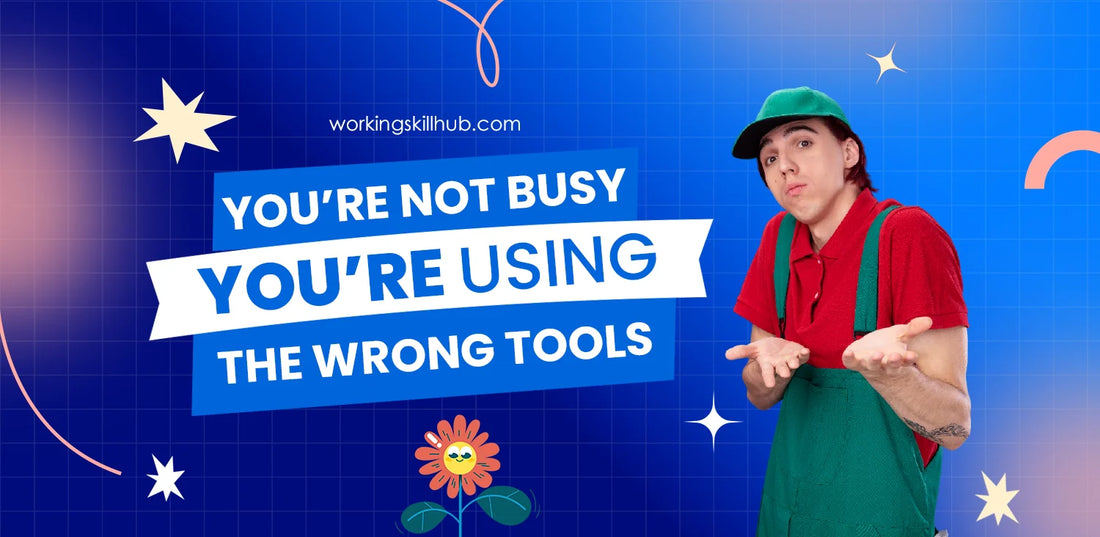“Busy” is usually a signal, not a badge. If your days are packed with follow-ups, rework, and recurring disputes, the problem is not your energy — it’s how you communicate. Poor communication creates a hidden “time tax”: it turns conversations into battles, meetings into detours, and relationship energy into overhead. The fix is tactical and repeatable: master connection as a tool, not just a goodwill gesture.
1. Busy ≠ Productive — busyness is often tactical failure
We treat “busy” as proof we’re important. But that confusion hides a simpler truth: most professionals are using a narrow set of mental and communicative tools. When those tools are outdated or poorly applied, small misunderstandings compound into hours of cleanup.
Key point: this is not a moral failure. It’s a design problem. You don’t need to work harder — you need better tools for connection.
2. The Time Tax of Perpetual Conflict
When communication turns colleagues into opponents, time disappears.
Why conflict costs so much
-
Defensiveness consumes energy. Criticism forces people to defend themselves, wasting creative mental bandwidth on justification rather than action.
-
Victories that cost goodwill are losses. Winning an argument can feel satisfying short-term but often destroys the collaborative relationship you’ll need later.
-
Anger and arguing reduce efficiency. Heated exchanges produce faster reactions but poorer decisions; the emotional charge lowers collective focus.
What to do instead
-
Shift from arguing to understanding. Prioritize tact, conciliation, and the desire to see the other side clearly.
-
Admit mistakes quickly and clearly. A fast, emphatic admission of error restores trust and removes friction. Example phrasing:
“You’re right — I missed that detail. My mistake. Here’s how I’ll fix it and prevent it next time.” -
Treat disagreements as puzzles, not battles. Ask questions that uncover underlying wants instead of proving points.
3. The Time Tax of Unfocused Meetings
If you leave meetings feeling unheard or exhausted, it’s likely because participants aren’t having the same kind of conversation.
The three conversation types (and why they matter)
-
Practical (What’s This Really About?) — Decision, facts, next steps.
-
Emotional (How Do We Feel?) — Safety, validation, team mood.
-
Social/Identity (Who Are We?) — Roles, status, team identity and reputation.
If you deliver facts while others need emotional reassurance, your message will miss. If you insist on identity claims when the group wants practical answers, you’ll spark defensiveness. The result: drift, repetitions, and unresolved follow-ups.
A simple intervention that works
Before a meeting, state a one-sentence goal that specifies both the aim and the mindset. Example:
“Goal: Surface two main concerns and decide on next steps—mindset: listen to understand, not to rebut.”
This small step aligns expectations, reduces argument, and dramatically lowers time spent re-hashing the same ground.
4. The Ultimate Tool for Efficiency: Connection as a Strategy
Connection isn’t a soft skill — it’s a high-leverage tool. Use it deliberately.
Core rule
Always think from the other person’s point of view: what they want, what they fear, what status they protect. The single most effective lever in any conversation is making the other person want the outcome you need.
Concrete tactics to apply today
-
Name the conversation type first. Example: “Are we here to decide, to vent, or to figure out who owns this?”
-
Lead with THEIR problem. Frame your opening around their interests: “I noticed X is costing the team Y; I’d like to propose Z to fix it.”
-
Ask one collaborative question before proposing. Example: “What would convince you this is worth pursuing?”
-
Use “Comm-YOU-nication.” Start impact statements with YOU or WE: “You’ll see faster approvals if…” or “We’ll reduce rework by…”
-
When criticized, respond with repair language: “Thanks — that’s a fair point. Here’s how I’ll adjust.”
-
Close meetings with a single agreed sentence of purpose and a named next step. Example: “We agreed to pilot X for two weeks; Sasha executes; check-in Friday.”
5. Practical scripts & templates
One-sentence meeting goal (aligns mindset):
“Goal: Surface the top 2 blockers and choose one immediate action—mindset: listen to understand.”
If someone becomes defensive:
“I hear why this matters to you. Help me understand which outcome would feel acceptable.”
If a meeting derails into argument:
“This is getting circular. Let’s pause—what outcome do we want from this conversation right now?”
Admitting you were wrong (fast repair):
“You’re right — I missed that. My mistake. I’ll take care of X and report back by Thursday.”
6. Quick checklist to reclaim your time
Before each meeting or heavy conversation, run this checklist:
-
Have I written a one-sentence goal + mindset for this meeting? ✔
-
Am I starting from the other person’s perspective? ✔
-
Did I ask a clarifying question before proposing a solution? ✔
-
Will I close with one action and a clear owner? ✔
-
Do I have a repair phrase ready if the conversation becomes heated? ✔
7. Stop paying the hidden tax
If your calendar is a patchwork of fixes, follow-ups, and rehashes, you’re paying a tax created by miscommunication. The remedy is not hustle — it’s tools: clarity about the kind of conversation, relentless attention to the other person’s point of view, and repeatable scripts that defuse conflict and create alignment. Use connection as a tactical tool, and your busyness will begin to evaporate.


